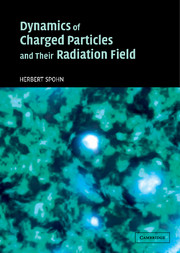Book contents
- Frontmatter
- Contents
- Preface
- List of symbols
- 1 Scope, motivation, and orientation
- Part I Classical theory
- 2 A charge coupled to its electromagnetic field
- 3 Historical notes
- 4 The energy–momentum relation
- 5 Long-time asymptotics
- 6 Adiabatic limit
- 7 Self-force
- 8 Comparison dynamics
- 9 The Lorentz–Dirac equation
- 10 Spinning charges
- 11 Many charges
- 12 Summary and preamble to the quantum theory
- Part II Quantum Theory
- References
- Index
4 - The energy–momentum relation
Published online by Cambridge University Press: 14 August 2009
- Frontmatter
- Contents
- Preface
- List of symbols
- 1 Scope, motivation, and orientation
- Part I Classical theory
- 2 A charge coupled to its electromagnetic field
- 3 Historical notes
- 4 The energy–momentum relation
- 5 Long-time asymptotics
- 6 Adiabatic limit
- 7 Self-force
- 8 Comparison dynamics
- 9 The Lorentz–Dirac equation
- 10 Spinning charges
- 11 Many charges
- 12 Summary and preamble to the quantum theory
- Part II Quantum Theory
- References
- Index
Summary
If the external forces vanish, the equations of motion must have a solution, in which the particle travels at constant velocity v in the company of its electromagnetic fields. There seems to be no accepted terminology for this object. Since it will be used as a basic building block later on, we need a short descriptive name and we call this particular solution a charge soliton, or simply soliton, at velocity v, in analogy to solitons of nonlinear wave equations. The soliton has an energy and a momentum which are linked through the energy–momentum relation.
For the Lorentz model, by Lorentz invariance, it suffices to determine the four-vector of total momentum in the rest frame, where it is of the form (ms, 0), ms being the rest mass of the soliton. ms depends on │ωE│. Through a Lorentz boost one obtains the charge soliton moving with velocity v and, of course, the relativistic energy–momentum relation. No such argument is available for the Abraham model and one simply has to compute its energy–momentum relation, which can be achieved along two equivalent routes. The first one is dynamic, as alluded to above, while the second one is static and directly determines the minimal energy at fixed total momentum. The minimizer is the charge soliton.
In the following two sections we compute the conserved energy and momentum, the charge solitons, and the energy–momentum relation for both the Abraham and the Lorentz model. ϕex = 0, Aex = 0 is assumed throughout.
- Type
- Chapter
- Information
- Dynamics of Charged Particles and their Radiation Field , pp. 44 - 53Publisher: Cambridge University PressPrint publication year: 2004

